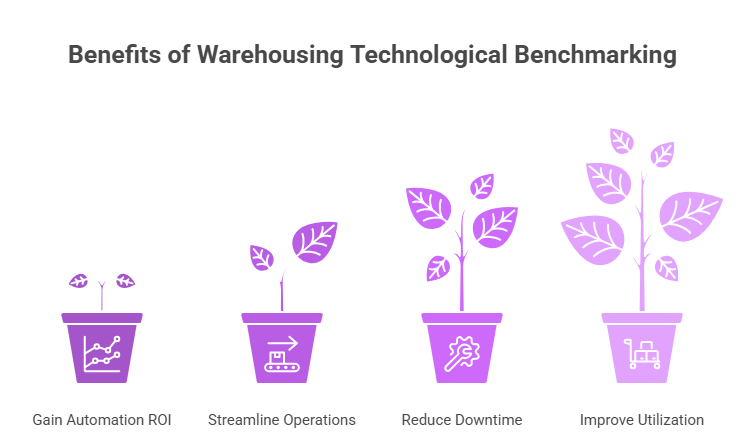The warehousing landscape has shifted from being storage-centric to performance-centric. Today, automation and digital integration define the efficiency, speed, and scalability of logistics networks. From autonomous mobile robots (AMRs) and AI-driven picking systems to IoT-enabled conveyors and warehouse management systems (WMS), technology now determines operational agility.
Yet, as logistics enterprises expand automation across facilities, a recurring challenge has emerged: how to measure what’s working and what’s not. Despite deploying advanced robotics, sensors, and analytics platforms, many operators struggle to identify where productivity losses occur or which technologies deliver the strongest ROI.
This performance blind spot prevents warehouses from reaching their full potential in throughput, accuracy, and energy efficiency.
That’s where technology benchmarking comes in. By comparing automation performance, integration maturity, and digital adoption levels across facilities and peers, logistics leaders can uncover inefficiencies and create a clear roadmap for continuous improvement.
Nexdigm’s Warehouse Automation Technology Benchmarking Framework
Automation in warehousing promises efficiency, but without measurable insights, investments can easily underperform. Nexdigm’s Warehouse Automation Technology Benchmarking Framework bridges this gap, enabling logistics and shipping enterprises to evaluate automation performance, digital maturity, and system integration across multiple sites and technologies.
This framework blends competitive intelligence, operational analytics, and ROI benchmarking to help businesses transform automation from a cost center into a measurable performance advantage.
Core Components of the Framework
- Comprehensive Automation Mapping: Nexdigm begins by mapping all automation technologies across facilities. This step identifies technology overlaps, workflow gaps, and underutilized assets.
- Equipment and Process Performance Benchmarking: Each system is evaluated on OEE (Overall Equipment Effectiveness) parameters such as throughput rate, cycle time, picking accuracy, and downtime. Comparative insights across peer facilities reveal process bottlenecks and improvement priorities.
- Integration and Data Synchronization Assessment: We benchmark how effectively warehouse technologies interact with WMS, ERP, and robotics control software, ensuring seamless information flow for real-time visibility and decision-making.
- Energy Efficiency and Cost Analysis: Nexdigm analyzes energy utilization, maintenance frequency, and operational cost patterns to identify automation systems that deliver high performance with minimal resource consumption.
- Predictive Maintenance and Reliability Benchmarking: By assessing the maturity of IoT-based predictive maintenance systems, Nexdigm helps enterprises shift from reactive equipment management to proactive reliability planning.
- Workforce and Automation Synergy Evaluation: Benchmarking includes an assessment of human-machine collaboration, evaluating task allocation, safety parameters, and productivity balance between automated systems and warehouse staff.
- ROI-Based Modernization Roadmap: Findings are translated into a data-driven modernization plan, outlining which automation upgrades yield the strongest ROI and how to sequence investments for maximum operational benefit.
Nexdigm’s benchmarking framework empowers logistics operators to see precisely how automation impacts performance. Thus, helping them enhance throughput, cut costs, and future-proof their warehouse networks.
Strategic Benefits for Logistics and Warehouse Operators
Benchmarking transforms automation from a tactical efficiency tool into a strategic differentiator. For logistics enterprises and warehouse operators, understanding where automation creates value is essential to staying ahead in a hyper-competitive industry.
Key Strategic Benefits

- Clear Visibility into Automation ROI: By comparing automation systems across facilities and competitors, companies gain a fact-based understanding of which technologies drive maximum throughput, accuracy, and cost savings.
- Streamlined Operations and Faster Fulfillment: Benchmarking uncovers bottlenecks in order picking, sorting, and replenishment, enabling operators to redesign workflows and boost speed-to-ship performance.
- Reduced Downtime and Maintenance Costs: Data-driven insights from predictive maintenance benchmarking help shift from reactive to preventive servicing, minimizing unexpected breakdowns and energy waste.
- Improved Energy and Space Utilization: Benchmarking energy usage and warehouse layout efficiency identifies optimization opportunities that reduce overhead costs and environmental footprint.
Through structured benchmarking, Nexdigm enables logistics enterprises to transform warehouses into intelligent, adaptive ecosystems, where automation is measured, optimized, and continuously improved.
To take the next step, simply visit our Request a Consultation page and share your requirements with us.
Harsh Mittal
+91-8422857704

